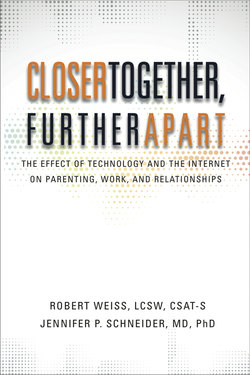Читать книгу Closer Together, Further Apart: The Effect of Technology and the Internet on Parenting, Work, and Relationships - Jennifer Schneider - Страница 7
На сайте Литреса книга снята с продажи.
The 800th Lifetime
ОглавлениеIn his seminal 1970 book Future Shock, Alvin Toffler wrote: “Almost invariably, research into the effects of change concentrate on the destinations toward which change carries us, rather than the speed of the journey. [But] the rate of change has implications quite apart from, and sometimes more important than, the directions of change.”2 In other words, human society is affected not only by changes, particularly technological changes, but by the speed with which they occur.
A useful concept to illustrate the ever-increasing pace of technological change is that of the 800th lifetime, introduced in Future Shock. There Toffler divided the approximately 50,000 years of relatively traceable human history into “lifetimes” of roughly 62 years, coming up with 800 lifetimes. He notes that the first 650 of those lifetimes were spent in caves. He then tells us that only during the last 70 lifetimes has it been possible to communicate effectively from one lifetime to the next (via written history), and only during the last six lifetimes has a significant percentage of the human population been able to access that written history/communication. He also notes that most of the products we now use on a day-to-day basis were invented very, very recently—during the 800th lifetime.3 For purposes of this book, our focus is the products or technologies that relate to the ways in which humans currently communicate and interact. This means we’re not particularly interested in washing machines. Except we are. Why? Because washing machines have, in their own way, affected interpersonal relationships.
Really?
Yes, really. Before Whirlpool and Tide came along, women took their small children and the family’s dirty laundry down to the river so they could rinse the soiled garments and beat them against rocks to knock out the dirt. While there, the children played together and the mothers had a chance to socialize face-to-face with their peers. And this thousands-of-years-old venue for female and child socialization is completely gone today—all thanks to the washing machine. This does not mean that women and kids no longer socialize and communicate with one another. Obviously they do. They just do it in different ways and different places. Numerous other inventions—too many to list here—have similarly changed how women, men, children, families, communities, and nations connect and communicate. This basic idea, that human-crafted technology impacts the nature of human communication, relationships, and thereby human evolution, is a main theme of this book.
